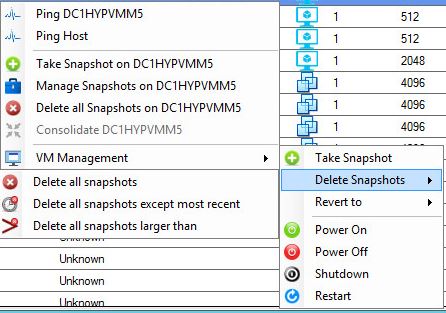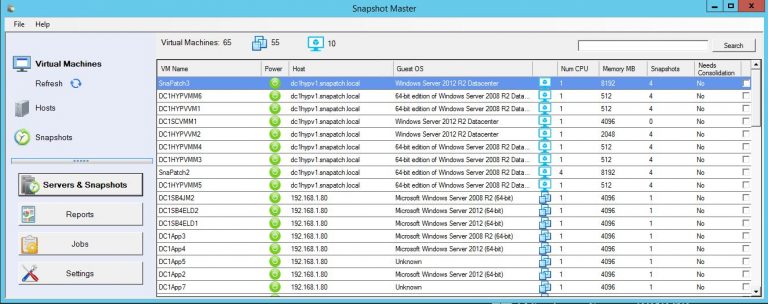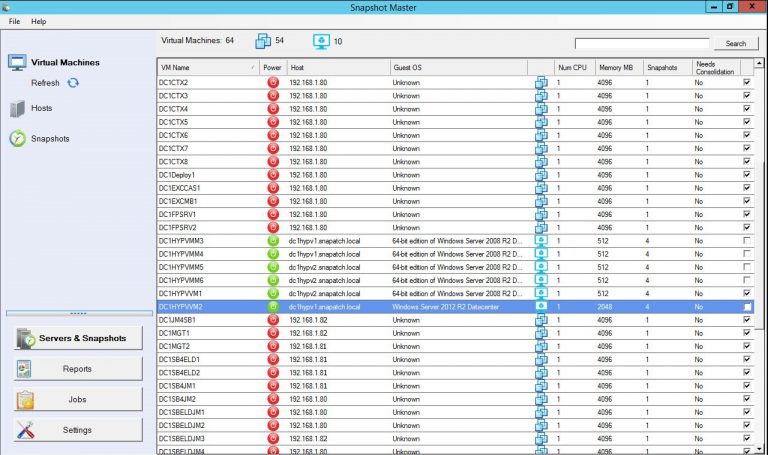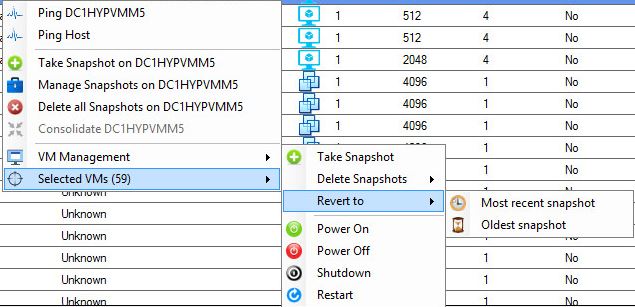Introduction to VM Snapshots
In the realm of virtualization, snapshots play an integral role in managing virtual machines (VMs). Essentially, a snapshot captures the state of a VM at a specific point in time, providing a reference point to which you can revert if necessary. This can be especially handy when implementing changes to your VM or its applications, allowing you to quickly undo the changes if they cause any unforeseen issues.
The Role of VM Snapshots
VM snapshots can be seen as a form of insurance policy for your virtual environment. By creating a snapshot before a significant update or modification, you’re ensuring that you have a way back in case something goes wrong. For instance, if you’re about to install a new software application on a VM, taking a snapshot beforehand can help you revert the VM to its pre-installation state if the new software causes any problems.
Types of VM Snapshots
There are mainly two types of VM snapshots: those with memory and those without memory. Each serves a different purpose and comes with its own set of characteristics and considerations. Understanding these differences is essential for effective VM management. Snapshots with memory include the VM’s memory state at the time the snapshot was taken, providing a complete snapshot of the VM’s operation. Conversely, snapshots without memory do not include the memory state and only capture the state of the VM’s disk.
The Importance of Effective Snapshot Management
While snapshots are undeniably useful, they also need to be managed effectively. Improper snapshot management can lead to a variety of issues, including wasted storage space, degraded performance, and even data loss in some cases. Fortunately, tools like Snapshot Master exist to help manage VM snapshots. These tools provide features like scheduled snapshot creation and deletion, snapshot consolidation, and automated reporting, significantly simplifying the task of snapshot management.
In this article, we will delve deeper into the differences between snapshots with memory and snapshots without memory. We’ll also discuss how tools like Snapshot Master can help you manage these snapshots more effectively, optimizing your VM operations while safeguarding your data.
The Purpose of VM Snapshots
VM snapshots serve an essential role in the management and operation of virtual machines. They provide a way to preserve the state of a VM at a given point in time, which can be highly beneficial in various scenarios. However, to utilize snapshots effectively, it’s critical to understand their purpose and how they function.
Capturing VM State
The primary purpose of a VM snapshot is to capture the state of the VM at a particular moment. This snapshot acts as a “checkpoint”, recording the VM’s current condition in terms of its memory, settings, and virtual disk.
For a snapshot with memory, this includes not only the disk’s state but also the state of the memory, along with the VM’s settings. This makes it possible to revert the VM to its previous state, including all running processes. This could be particularly beneficial in environments where applications require a continuous state of operation.
On the other hand, a snapshot without memory only captures the disk’s state and the VM’s settings but does not capture the memory’s state. This type of snapshot is quicker to create and uses less storage. However, when reverted, the VM may need to be rebooted, and ongoing processes will not be maintained.
Preventing Data Loss and Facilitating Recovery
Snapshots act as a safety net, helping prevent data loss and facilitate recovery. If you’re making significant changes to your VM, such as installing new software or updating the system, a snapshot taken beforehand can provide a fallback option. If the changes result in unforeseen issues or data loss, you can quickly revert the VM to its state at the time of the snapshot, effectively undoing the problematic changes.
Testing and Development
Snapshots are also extremely useful in testing and development scenarios. They allow developers and testers to experiment with different configurations, applications, or system updates without risking the stability of the primary VM. Once testing is complete, the VM can easily be reverted back to its original state by applying the snapshot, eliminating the need for a time-consuming manual rollback.
Snapshot Management
While snapshots are undeniably useful, they also need to be managed effectively. An unmanaged accumulation of snapshots can consume a large amount of storage space and degrade VM performance over time. Snapshot management tools like Snapshot Master can simplify the process of creating, managing, and deleting snapshots, ensuring that your VM environment remains efficient and performant.
In the following sections, we’ll delve into the differences between snapshots with memory and snapshots without memory, and explore how they can be managed effectively for optimal VM operation.
Understanding Snapshots: With Memory Vs. Without Memory
Understanding the nature of snapshots, specifically snapshots with memory and snapshots without memory, is crucial when dealing with virtual machines (VMs). In essence, both these types of snapshots are used to capture the state of the VM at a particular point in time, but they do so in slightly different ways and for different reasons.
What are Snapshots with Memory?
Snapshots with memory are a comprehensive form of VM snapshot. They encapsulate not just the state of the virtual disk but also the state of the VM’s memory at the time the snapshot was taken. This memory state is crucial for certain types of applications and processes that might be running on the VM. For instance, if your VM is running complex processes or transactions that would be disrupted by a restart, a snapshot with memory can be invaluable. This snapshot type maintains the full context of the VM’s operation, including all ongoing processes, allowing for seamless recovery with no loss of transactional data.
The ability to capture the memory state can also be useful in scenarios like software debugging, where you might want to revert the VM to a previous state without disturbing ongoing processes. While snapshots with memory tend to consume more storage space and can have a more significant impact on performance, they can also provide more granular recovery options for complex VM environments.
What are Snapshots without Memory?
On the flip side, snapshots without memory capture only the state of the virtual disk and not the memory state. These types of snapshots are lighter, faster to create, and consume less storage space. They can be created with minimal impact on the VM’s performance, making them suitable for VMs that do not run memory-sensitive processes.
However, the trade-off for these performance benefits is that a snapshot without memory may require the VM to reboot when you revert to that snapshot. Consequently, any running applications or processes would need to restart. For some environments, this is a negligible downside, especially if speed and storage efficiency are the priority. For others, particularly those with VMs running critical, continuous processes, it’s a crucial factor to consider.
Knowing the characteristics and implications of both snapshots with memory and snapshots without memory can help you make informed decisions when managing your VM environments. And tools like Snapshot Master can significantly simplify the process of creating, managing, and using these snapshots effectively.
Snapshot Considerations: Performance and Application Consistency
Taking snapshots, whether with memory or without, can impact your virtual machine’s performance and application consistency. Understanding these impacts can help you decide which type of snapshot is best suited for your specific use case.
Snapshot Performance Impacts
The process of taking a snapshot requires certain system resources. For a snapshot without memory, these resources include the storage required to record the VM’s disk state. As for a snapshot with memory, additional resources are required to also record the state of the VM’s memory. Therefore, creating a snapshot with memory typically consumes more resources and can take longer, which could potentially impact the VM’s performance.
However, this performance impact is generally temporary and diminishes once the snapshot is complete. Hence, it’s crucial to plan snapshot activities during off-peak hours to minimize the impact on VM performance and user experience.
Disk I/O Considerations
When a snapshot is taken, the VM’s writes are redirected to a delta disk file, a process known as disk I/O redirection. This process occurs regardless of whether the snapshot is with or without memory. The longer the snapshot is kept, the larger this delta file can grow, which can further influence disk I/O operations and hence VM performance. Therefore, snapshots should not be kept for an extended period, and ongoing snapshot management is necessary to mitigate any potential performance impacts.
Restoring VM State
The purpose of a snapshot is to be able to restore a VM to a specific point in time. Snapshots without memory, while faster and lighter, may need the VM to reboot when you revert to the snapshot. This can impact the availability of services running on the VM. In contrast, snapshots with memory can restore the VM without requiring a reboot, thereby maintaining service availability. The choice between these two types of snapshots will depend on the specific requirements and tolerance for service interruption in your VM environment.
Application Consistency
When it comes to application consistency, snapshots with memory hold an advantage. For applications that need to maintain a constant state even during recovery, snapshots with memory are the better option. They can restore the VM with all running applications and processes intact, ensuring application consistency. This is particularly useful in environments running critical applications that cannot tolerate disruptions.
On the other hand, snapshots without memory may require a reboot of the applications when you revert to the snapshot. This could potentially disrupt application consistency, which might not be ideal for certain environments.
By considering these factors, you can choose the appropriate snapshot type that balances performance, disk I/O, service availability, and application consistency according to your specific needs. Snapshot Master can help manage these aspects effectively, allowing for seamless snapshot operations.
Benefits of Using Snapshot Master for Managing VM Snapshots
Snapshot Master is an indispensable tool for anyone managing VM environments. It streamlines various aspects of VM management, especially dealing with snapshots, checkpoints, and data stores. Let’s look at some of its key features in more detail:
Scheduled Snapshot Creation and Deletion
One of the prominent features of Snapshot Master is the ability to schedule snapshot creation and deletion. This functionality ensures that you have up-to-date snapshots available for any point in time. You can set specific times for the software to create or delete snapshots according to your operational needs, thereby automating a significant aspect of VM management. This not only ensures optimal use of resources but also reduces the burden of manual oversight.
Snapshot Consolidation
Over time, you may end up with multiple snapshots for a single VM, which can consume a significant amount of storage space. Snapshot Master offers a snapshot consolidation feature to help with this. By merging these multiple snapshots into one, the tool ensures efficient usage of your storage resources, leading to improved overall performance of your VM environment. Moreover, consolidating snapshots also reduces the risk of running into storage issues due to excessive snapshots.
Automated Reports and Notifications
In the world of IT management, staying informed about your infrastructure’s status is crucial. Snapshot Master assists here by providing automated reports and email notifications. You can receive timely updates about your VM’s status, snapshot creation or deletion events, and data store usage. These reports can provide valuable insights into your VM operations and highlight potential issues before they escalate. The notifications ensure that you’re aware of significant events or changes in your VM environment, allowing for proactive management and timely intervention when necessary.
Remote VM Management
In addition to managing snapshots, Snapshot Master also offers remote VM management capabilities. You can power your VMs on or off, connect to them remotely via RDP or PowerShell, and execute Remote PowerShell commands. This feature is incredibly handy when managing a large number of VMs, allowing you to execute tasks or make changes without needing to access each VM individually.
Comprehensive Compatibility
Snapshot Master’s compatibility with VMWare’s vCentre, Microsoft’s System Center Virtual Machine Manager (SCVMM), and Microsoft Azure means that you can have a unified view and control of your VM environment, regardless of the platform. This comprehensive compatibility makes it a versatile tool suitable for various VM setups.
By integrating these features into your VM management, Snapshot Master can significantly simplify your tasks and ensure efficient operations, making it a vital tool in any IT administrator’s toolkit.
Managing VM Snapshots: Some Practical Tips
Managing snapshots in a virtual environment requires a balance between operational needs and resource usage. Both snapshots with memory and without memory have their unique advantages and trade-offs. As such, it’s crucial to develop a snapshot management strategy that suits your specific VM environment and operational requirements. Let’s delve into some practical tips for managing your VM snapshots effectively:
Use Snapshots Judiciously
While snapshots are beneficial, they should not be overused. Every snapshot that you take consumes storage resources. Over time, excessive snapshot usage can lead to storage issues and impact your VM’s performance. Thus, it’s advisable to use snapshots judiciously, keeping them for necessary moments such as before implementing significant changes to your VM or its applications.
Regularly Delete Unnecessary Snapshots
Snapshots are not intended for long-term data retention. They are temporary entities designed to capture the state of a VM at a specific point in time. Therefore, maintaining old or unnecessary snapshots can consume valuable storage resources that could otherwise be utilized more efficiently. Regularly cleaning up old snapshots, especially those no longer needed, is an essential practice in VM management.
Rely on Robust Backup Solutions
While snapshots can provide a quick way to revert a VM to a previous state, they are not a substitute for a robust backup solution. VM snapshots, particularly those without memory, can’t guarantee complete data integrity over the long term. A comprehensive backup solution is necessary for long-term data retention and protection against data loss. It ensures that you have a complete copy of your data stored separately from your VM, which can be crucial in the event of hardware failure or data corruption.
Utilize Snapshot Management Tools
Effective VM snapshot management can be challenging without the right tools. Tools like Snapshot Master simplify this process significantly. They offer features such as scheduled snapshot creation and deletion, snapshot consolidation, automated reports and notifications, and more. With such a tool, you can manage your snapshots more efficiently, ensuring that your VM environment remains healthy and performant.
These practical tips serve as a guide to managing your VM snapshots. Remember, the ultimate goal of snapshot management is to maintain the optimal performance and availability of your VMs while ensuring data integrity. And tools like Snapshot Master can play an integral role in achieving this goal.
Frequently Asked Questions (FAQs)
Q1: Can I use Snapshot Master with any VM platform?
A1: Yes, Snapshot Master is designed to interface with VMWare’s vCentre, Microsoft’s System Center Virtual Machine Manager (SCVMM), and Microsoft Azure. So, it covers a wide range of popular VM platforms.
Q2: How long does it take to create a snapshot with memory compared to one without memory?
A2: The exact time will depend on the specific VM setup and the current workload. However, generally, creating a snapshot with memory takes longer due to the added task of capturing the memory state.
Q3: Do snapshots with memory affect VM performance?
A3: Yes, creating snapshots with memory can temporarily impact the VM’s performance due to the higher I/O workload. However, this effect is typically short-lived.
Q4: What is the best strategy for managing VM snapshots?
A4: A good strategy is to only use snapshots as short-term solutions for system changes or updates, and not as long-term backup solutions. Furthermore, regular cleanup of old snapshots can help maintain efficient storage usage.
Q5: Is it possible to automate the creation and deletion of VM snapshots?
A5: Yes, Snapshot Master provides the feature to schedule snapshot creations and deletions, helping automate the management of your VM environment.
Q6: Are snapshots with memory larger in size compared to those without memory?
A6: Yes, because snapshots with memory include the state of the VM’s memory in addition to the virtual disk’s state, they tend to be larger than snapshots without memory.
Q7: Is Snapshot Master useful only for snapshots?
A7: No, Snapshot Master also allows you to manage your virtual machines, schedule power on and off, connect to them remotely via RDP or PowerShell, and execute Remote Powershell.
Q8: Can I revert a VM to its previous state using Snapshot Master?
A8: Absolutely. Snapshot Master enables you to revert VMs to their previous states using the created snapshots, thus offering an effective way to recover from any potential issues.
Q9: Does Snapshot Master provide any reporting features?
A9: Yes, Snapshot Master lets you automate and schedule reporting of your virtual servers and VMware or Hyper-V environments via email, providing you with regular updates and insights.
Q10: Does a snapshot with memory ensure application consistency?
A10: Yes, a snapshot with memory can maintain a VM’s running applications and processes, ensuring application consistency during recovery.







